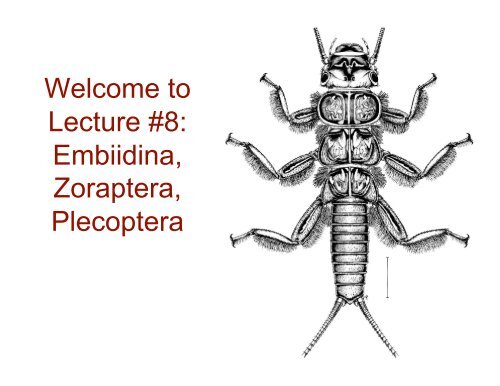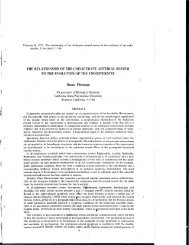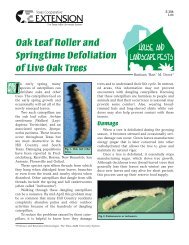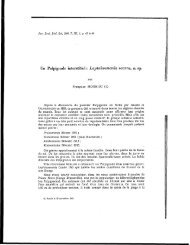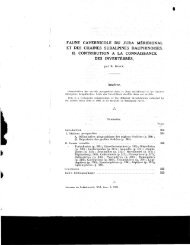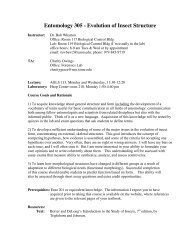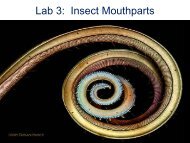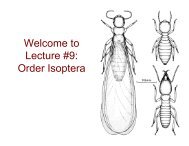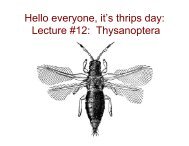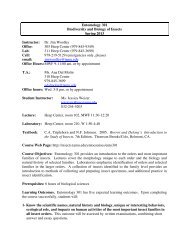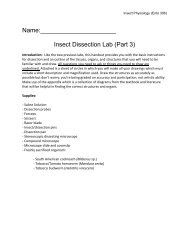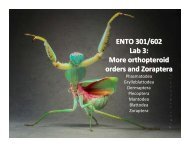Welcome to Lecture #8: Embiidina, Zoraptera, Plecoptera
Welcome to Lecture #8: Embiidina, Zoraptera, Plecoptera
Welcome to Lecture #8: Embiidina, Zoraptera, Plecoptera
Create successful ePaper yourself
Turn your PDF publications into a flip-book with our unique Google optimized e-Paper software.
<strong>Welcome</strong> <strong>to</strong><br />
<strong>Lecture</strong> <strong>#8</strong>:<br />
<strong>Embiidina</strong>,<br />
<strong>Zoraptera</strong>,<br />
<strong>Plecoptera</strong>
Collembola<br />
Protura<br />
Diplura<br />
Microcoryphia<br />
Thysanura<br />
Ephemeroptera<br />
Odonata<br />
Apterygota<br />
Orthoptera<br />
Phasma<strong>to</strong>dea<br />
Grylloblat<strong>to</strong>dea<br />
Man<strong>to</strong>phasma<strong>to</strong>dea<br />
Dermaptera<br />
<strong>Plecoptera</strong><br />
<strong>Embiidina</strong><br />
Paleoptera<br />
<strong>Zoraptera</strong><br />
Isoptera<br />
Man<strong>to</strong>dea<br />
Blat<strong>to</strong>dea<br />
Hemiptera<br />
Thysanoptera<br />
Pscoptera<br />
Phthriptera<br />
Coleoptera<br />
Neuroptera<br />
Hymenoptera<br />
Trichoptera<br />
Lepidoptera<br />
Today<br />
Siphonaptera<br />
Mecoptera<br />
Strepsiptera<br />
Diptera<br />
Phylogeny of Hexapoda<br />
(text figure 6-1)
Phylogeny of<br />
Hexapoda<br />
To Orthoptera,<br />
Paleoptera, etc.<br />
(<strong>to</strong> Hemiptera and<br />
Holometabola)<br />
<strong>Embiidina</strong><br />
<strong>Plecoptera</strong><br />
<strong>Zoraptera</strong><br />
Isoptera<br />
Man<strong>to</strong>dea<br />
Blat<strong>to</strong>dea
Order <strong>Embiidina</strong><br />
Web-Spinners<br />
• biting/chewing mouthparts<br />
• female wingless,<br />
• male with or without wings<br />
• legs short, fore basitarsus globose<br />
and containing silk glands<br />
• no ocelli.
Order <strong>Embiidina</strong><br />
Web-Spinners<br />
• biting/chewing mouthparts<br />
• female wingless<br />
• male with or without wings<br />
• legs short, fore basitarsus globose<br />
and containing silk glands<br />
• no ocelli
Basal segment of fore tarsus
<strong>Embiidina</strong>
<strong>Embiidina</strong><br />
pho<strong>to</strong> by Alex<br />
Wild (2005)
Adult female<br />
Egg on wall of gallery<br />
First instar larva Larva in gallery
<strong>Embiidina</strong><br />
pho<strong>to</strong> by Alex<br />
Wild (2005)<br />
Video!<br />
(thanks <strong>to</strong> Roxanna Martinez, 2010)
• biting/chewing<br />
mouthparts<br />
• aquatic immatures<br />
(naiads:<br />
hemimetabolous)<br />
• large, membranous fore<br />
and hind wings<br />
• tarsi 3-segmented<br />
• legs cursorial<br />
• cerci present, often long<br />
Order <strong>Plecoptera</strong><br />
S<strong>to</strong>neflies
Order <strong>Plecoptera</strong> S<strong>to</strong>neflies<br />
• biting/chewing mouthparts
Order <strong>Plecoptera</strong> S<strong>to</strong>neflies<br />
• cerci present, often long
Order <strong>Plecoptera</strong> S<strong>to</strong>neflies
<strong>Plecoptera</strong>
<strong>Plecoptera</strong>
<strong>Plecoptera</strong>
<strong>Plecoptera</strong><br />
nymphs
Order <strong>Plecoptera</strong> - S<strong>to</strong>neflies
<strong>Plecoptera</strong>
Perlidae – common s<strong>to</strong>neflies<br />
• Adults do not<br />
feed<br />
• Nymphs are<br />
mostly<br />
preda<strong>to</strong>rs<br />
• Generally in
Nemouridae – Spring s<strong>to</strong>neflies<br />
• Occur in<br />
small<br />
streams<br />
with rocky<br />
bot<strong>to</strong>ms<br />
• Nymphs<br />
are plant<br />
feeders
Order <strong>Zoraptera</strong> -<br />
Angel Insects<br />
• biting/chewing mouthparts<br />
• 2 pairs of membranous<br />
wings with very reduced<br />
venation sometimes<br />
present<br />
• antennae moniliform<br />
• tarsi are 2-segmented<br />
• cerci are present
Order <strong>Zoraptera</strong> -<br />
Angel Insects<br />
• biting/chewing mouthparts<br />
• 2 pairs of membranous<br />
wings with very reduced<br />
venation sometimes<br />
present<br />
• antennae moniliform<br />
• tarsi are 2-segmented<br />
• cerci are present
<strong>Zoraptera</strong><br />
• 2 pairs of membranous wings with very reduced<br />
venation sometimes present
<strong>Zoraptera</strong>
<strong>Zoraptera</strong>
<strong>Zoraptera</strong><br />
One Family = Zoratypidae


